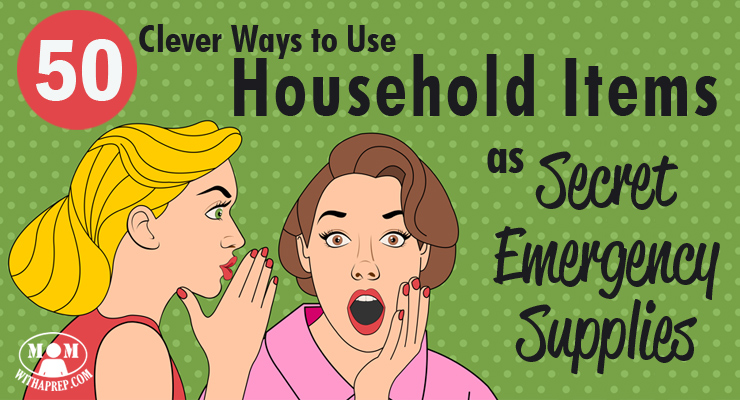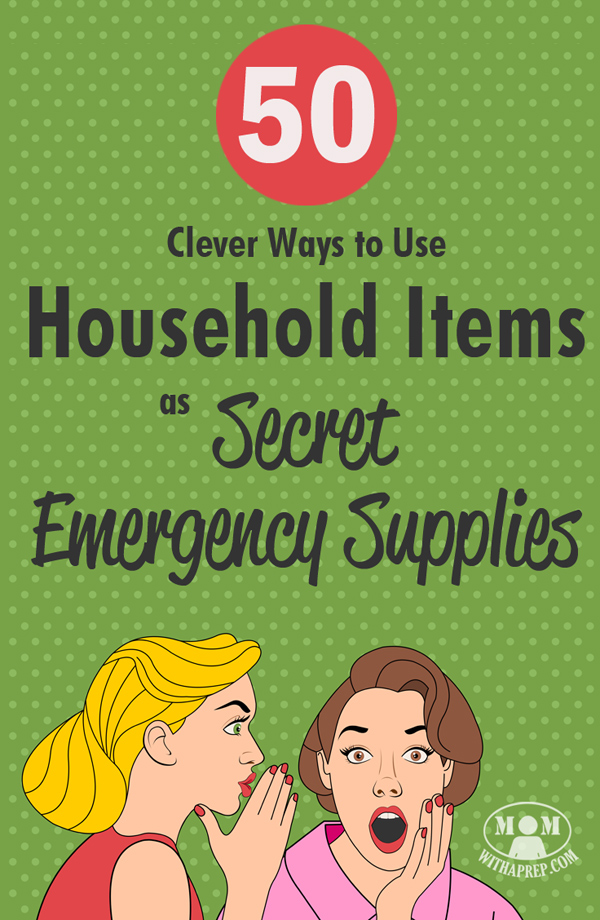Do you ever find yourself staring at household items and wondering what to do with them when their initial purpose is used up? When emergencies come, we sometimes find that we are not as prepared for all the needs that arise as we would like to be. While we all know the typical items to have in a home to be prepared for most emergencies, you might find that you have household items that will help you that you may have never thought of!

This isn’t a complete list of every item that can be multi-tasked into a survival object. Nor are all of these ideas things you want to rely on, but they are things that can be used in a pinch. This is to help you begin thinking outside of the standard box of what household objects might be used for and see their potential of being used for something more when needed.
50+ Clever Ways to Use Household Items as Emergency Supplies
Bleach
Not only is bleach perfect for disinfecting your clothes, countertops and bathrooms after a sickness, it can be used to disinfect your water, too.
- If water is clear, add 1/8 teaspoon of unscented, household bleach to a gallon of water.
- If water is cloudy, add ¼ teaspoon, instead.
- Mix and allow to stand for 30 minutes.
Make sure your bleach is not older than six months as the sodium hypochlorite begins to break down and return to its natural state of salt and water at that point and is no longer effective to purify your water.
Protect your family’s health and make your water the cleanest it can be. A Berkey Water Filter system removes bacteria, viruses, and chemicals from your water while leaving in the beneficial minerals your body needs.
Bed sheets
Bed sheets are a wondrous material that can transform a child’s world into the coolest castle or fortress when making forts with chairs in your living room, but they also serve as a multi-functional canvas in an emergency:
- protect gardens from frost;
- cut them into strips for bandages;
- cut into large squares to make slings for damaged arms;
- make into baby sling from com’s baby expert;
- fashion large sections into a face mask to protect from smoke and dust;
- make privacy screens in rooms where there are sick or you’re sheltering up with others.
- Get even more ideas here.
Cotton Balls
- can serve as tinder for starting a fire. They work especially well if you can mix them with petroleum jelly, candle wax or lip balm, but work well without them, too.;

- can be used to pack small wounds to stop bleeding when nothing else is available;
- stock only 100% cotton as the polyester blended ‘cotton’ balls are not as useful in these situations;
- use as ear plugs to sleep in case you’re in a shelter after a disaster.
| Preview | Product | |
|---|---|---|

|
Perfect Stix - Cotton Balls M-500ct Cotton Balls M Cotton Balls, Pack... | Buy on Amazon |
Trash Bags
- use to collect water;
- use to protect items from getting damaged from rain or water;
- use as a rain poncho or ground cover;
- use as shelter – open the bag by cutting along the side and bottom and draping over a chair or makeshift tent structure.
- black bags can be used to heat water by placing a full bag out in the sun for a few hours and allowing the sun’s radiation to heat the water.
- Get even more ideas here
Cell phone
With all of the apps that are available on the market today, your cell phone can be a lifesaver for more than making calls to 9-11. First aid apps, flashlight apps, reference library, weather apps and more are available to make the cell phone an invaluable tool for emergencies. Check out the Google Play Store or iTunes for apps for your particular phone.
Plastic Soda Bottles
- Storing dry goods (and use wax to seal the cap on to keep for longer storage);
- break down to make a broom head;
- Filter water;
- Hothouses for newly planted vegetables;
- fill with water emergenc drinking and store in freezer to help it work more efficiently;
Drinking Straws
When making storage tubes like these, you can use an iron, a hair straightener, or a small heat sealer (which is good to reseal plastic bags that you store food in if you don’t want to drag out your vacuum sealer).
- make individual servings of spices and herbs and drink supplements;
- cut the top off to make a funnel, the bottom off to make a bowl;
- make small tubes of first aid creams;
- make fire starter straws;
- purify water in a clear bottle using the sun
- Get even more ideas here!
Coffee Filters
- use as liners in flower/vegetable pots – but beware – it will eventually break down, but can be used in a pinch when you have nothing else;
- filter sediment from water;
- make your own teabags – when you’ve grown enough herbs for making tea, you can use the filter to create a tea bag to steep them in (if you don’t like doing loose tea), and use the string from a tampon for a tea bag string!
- Get more ideas here.
Frozen bags of vegetables
They aren’t just for dinner anymore!
- use a bag of frozen vegetables as an ice pack to help relieve that swelling or relieve pain from a burn or bump;
- use on the back of neck to help cool body down in extreme heat.
Duct Tape
The miracle tool that helped the space program can also help you in an emergency situation. Gorilla tape works even better than standard duct tape.
- Wrap a sprained ankle to stabilize;

- Create a sling for a broken or sprained arm. Fold a long length of duct tape down the middle to create a ‘rope’, then stabilize the arm and tie at the shoulder;
- Mend a tear in just about anything. Use to seal a broken window, a tear in tent fabric or clothing, seal a wound if you have nothing else, a leaking pipe, etc.;
- Tape onto windows before a storm arrives to help prevent flying glass if the window breaks;
- Open a jar. While it’s important to keep a manual jar opener at home for power outages, duct tape can work by wrapping a length around ½ of a jar lid, then using the excess to pull the jar open (see video here).
Tin cans
Once done with a meal you grabbed from the pantry in an emergency, turn around and use that can for:
- use as a cup or serving device;
- use as a portable cook pot to boil water or heat other food (though don’t do it closed and use an insulating glove as it will be hot;
- create a rocket stove
- make a candle holder / lamp – punch holes in the side with a long nail to create more space for light to shine through.
Socks
Not only are socks great for keeping your feet warm, they are versatile for a variety of other emergency situations.
- can serve as water filters to filter out debris;
- use as gloves to keep hands warm;
- cover glass canning jars for transport or deep storage
- use as a heat pack – fill with rice or cherry pits and place in microwave for 1-2 minutes and place on damaged or sore area, or stick into a bed to help warm it in the cold;
- use as a freeze pack – use that same rice-filled bag from the freezer to help soothe aching cuts and bruises, swelling from trauma and more.
- fill long tube socks or create a line of socks filled with rice and place at door threshholds to keep drafts at bay.
- place over a regular ice pack to keep the ice from burning your skin.
Plastic bags
While most grocery bags aren’t necessarily useful because they are poorly made to degrade faster in landfills, certain big box stores still make excellent bags to use, or think of using a zip-top brand that you normally store food in. The varying sizes make them useful for all sorts of issues in an emergency:
- collect water;
- protect important documents from water damage;
- use clear zip top bags to purify water with the sun;
- place over feet to keep them warm and dry;
- wrap your side view mirrors with the bag and tie it off tightly to help keep them clean during an ice storm. Remove when ready to drive and it’s one less surface to have to de-ice;
- inflate large zip top bag and seal to create a makeshift pillow (may need to seal with duct tape);
- cover injured and bandaged appendages to protect from getting wet.
- use a zip top bag to create an gel ice pack for keeping foods cool when you have no power (or even lunches on the go) or for soothing areas swollen from trauma.
Cat Litter
I suggest using only plain clay cat litter for these uses. The multi-cat, super absorbant, smells like your grandma’s perfume litters may contain chemicals you don’t want to use in these circumstances. However, in an emergency….use what you can!
- spread along sidewalks and porches to give traction in the snow/ice;
- use behind or in front of your wheels if you’re stuck in the ice to give wheels traction;
- use to absorb water or leaked liquids from a storm.
- fill a sock with simple cat litter (not the super absorbancy smelly kind unless you like that smell everywhere), and place it with your camping gear to help absorb odors and moisture and keep your gear in better shape. This can work for everyday household things like smelly shoes or a musty room or books, and even in your refrigerator (which may need it after an extended power outage).
- help prevent grease fires by pouring a thin layer into the bottom of your grill where grease tends to settle. Again,
Baking Soda
- use ½ teaspoon per 8 oz. of water to help treat stomach aches and indigestion;
- use to tamp out a grease fire on the kitchen stove or garage. While it’s better to use a lid to cover the fire, if you have a box of baking soda handy, you can get a head start on putting out the fire according to the Rocky Mountain Fire Department;
- mix with water to help relieve itchy skin from bug bites, sunburns and other skin irritants.
Brooms
- use broom handle to place in the track of a sliding glass door or window to help lock it.
- use as a weapon.
- use as a walking stick in the case of a leg injury.
Women’s Hygiene Products
- tampons can be used to plug nosebleeds or bullet wounds.
- sanitary napkins can be used as wound dressing or to pack a bleeding wound.
- tampons can serve as water filters.
- tampons can also be used as kindling to start a fire.
- tampons can be used as ear plugs. Trust me..some nights I might want to kill the person laying next to me because they’re snoring so much. In an emergency…it might save his life 🙂
Storage Containers
Plastic tubs, bins and containers – you know those plastic tubs that hold all of your holiday decorations in your garage?
- use to collect water;
- use as an emergency toilet;
- storage for food and clothing if you’ve lost most everything;
- use to plant – whether you are living in an extended emergency or find yourself living with relatives or in housing you didn’t really choose during recovery, you can still grown your own food. Use these tubs to grow food in. (This is our lettuce bed growing in a Sterlite sweater box) They aren’t meant for outdoor use, so won’t last more than a season or two, but they are great for emergency containers gardens if you can’t plant in the ground.
Every practical thing in your home can be a multi-tasking emergency item.
Being of a mindset to understand how to use things differently can help you protect your family during an emergency situation. To learn even more ways to start learning about emergency preparedness with your family, click here!
Katy Willis is a writer, lifelong homesteader, and master herbalist, master gardener, and canine nutritionist. Katy is a preparedness expert and modern homesteader practicing everyday preparedness, sustainability, and a holistic lifestyle.
She knows how important it is to be prepared for whatever life throws at you, because you just never know what's coming. And preparedness helps you give your family the best chance to thrive in any situation.
Katy is passionate about living naturally, growing food, keeping livestock, foraging, and making and using herbal remedies. Katy is an experienced herbalist and a member of the CMA (Complementary Medical Association).
Her preparedness skills go beyond just being "ready", she's ready to survive the initial disaster, and thrive afterward, too. She grows 100% organic food on roughly 15 acres and raises goats, chickens, and ducks. She also lovingly tends her orchard, where she grows many different fruit trees. And, because she likes to know exactly what she's feeding her family, she's a seasoned from-scratch cook and gluten-free baker.
Katy teaches foraging and environmental education classes, too, including self-sufficient living, modern homesteading, seed saving, and organic vegetable gardening.
Katy helps others learn forgotten skills, including basic survival skills and self-reliance.
She's been published on sites such as MSN, Angi, Home Advisor, Family Handyman, Wealth of Geeks, Readers Digest, and more.
Last update on 2024-07-27 at 02:37 / Affiliate links / Images from Amazon Product Advertising API








Please remove wound packing from the cotton ball category.. While it would probably work there is a high risk that foreign material (cotton) would be left behind when the wound is repaired leading to wound dehiscence (reopening), infection, and sepsis. The risk of retained cotton foreign body is higher when a victim moves through multiple services (bystander, medic, ER, surgery) and the actual count may be lost if it was known at all. Double this for a SHTF situation where the repair is done outside a controlled OR without sedation or adequate lighting . Rolled gauze is best for packing but shove a sock, t shirt, pillowcase in the wound before cotton balls or tampons (which cannot provide enough pressure other than nose bleeds and certain anecdotal cases).